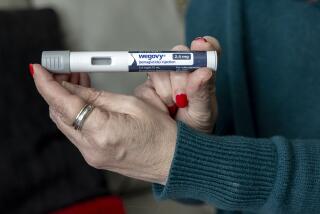Michael Mosley puts his health to many tests
The patient in his 50s was mildly overweight, had high cholesterol and was headed down the road to diabetes. Common problems, and his doctor made the usual recommendation: medications. But the patient, Michael Mosley — a British author, journalist, TV personality and doctor himself — decided to go a different route. He traveled around his own country and ours, interviewing leading researchers, then tested some of their latest findings. The result? “The Fast Diet,” a bestselling book in Britain (it has nothing to do with fast food, how fast you eat or even how fast you lose weight), as well as a three-part PBS series. (The first two have already aired. The third airs Wednesday.)
What is “The Fast Diet”?
The Fast Diet is based on studies of intermittent fasting. My version involves eating normally for five days a week and eating 600 calories a day twice a week. When I first started, I found it quite difficult as I got distracted by occasional hunger pangs. But I found, as many others have who tried it, that these hunger pangs soon pass, and I had no problem sticking to the diet. Within a couple of months of starting, I had lost 19 pounds of fat, and both my cholesterol and glucose levels had markedly improved.
That was over nine months ago. I have kept the weight off, and my [blood levels] are still good. These days I only cut calories one day a week, and that is sufficient to keep my weight steady at around 168 pounds. I feel good on the diet and rarely feel hungry.
You also investigated the health benefits of exercise. What did you find out?
People respond to exercise in very different ways. In one international study 1,000 people were asked to exercise four hours a week for 20 weeks. Their aerobic fitness — how efficiently your heart and lungs get oxygen into your body — was measured before and after starting this regime, and the results were striking.
Although 15% of people made huge strides (so-called super-responders), 20% showed no real improvement (non-responders).
There is no suggestion that the non-responders weren’t exercising properly. It was simply that the exercise they were doing was not making them any aerobically fitter.
It turns out that much of the difference can be traced to a small number of genes. On the basis of this finding, scientists have developed a genetic test to predict who is likely to be a responder and who is not.
Did you test any exercise programs on yourself?
I tested the claim that you can benefit from just three minutes a week of really intense exercise. When I first read that high-intensity training, or HIT, could make significant and measurable changes to my fitness, I was incredulous. But this apparently outrageous claim is supported by many years of research in a number of different countries, so I decided to give it a go.
The idea is that you get on an exercise bike and, after a minute or so of gently warming up, you pedal like crazy for about 20 seconds against high resistance. You then pedal gently for about two minutes before pedaling like crazy for another 20 seconds. After another two minutes of gentle pedaling, you do a final burst of 20 seconds. That is it for the day. You then simply repeat this three times a week.
How is HIT supposed to work, and did it work for you?
HIT uses far more of our muscle tissue than classic aerobic exercise — not just the leg muscles but also the upper body, including arms and shoulders — so that 80% of the body’s muscle cells are activated, compared to 20% to 40% for walking or moderate intensity jogging or cycling.
Active exercise also seems necessary for breaking down the body’s stores of glucose, deposited in your muscles as a substance called glycogen. Smash up these glycogen stores, and you create room for more glucose to be sucked out of the blood and stored.
The first thing I was interested in was the effect of HIT on my insulin sensitivity. Insulin removes sugar from the blood. It controls fat, and when it becomes ineffective, you become diabetic. My father was a diabetic and died from complications of that disease. Research from a number of centers has shown that three minutes of HIT a week improves insulin sensitivity by an average of 24%.
The second improvement I was hoping to see was in my aerobic fitness, which is an excellent predictor of future health. In both of these ways, HIT worked well for me.
You recently put on an unusual display of, shall we say, intestinal fortitude. What was that about?
I agreed to swallow a mini-camera and allow the pictures it was taking to be seen by hundreds of enthusiastic spectators at the world-famous Science Museum in London.
The world of our guts is normally a dark, dank, private one. Down there live creatures that have never seen the light of day, more than 50 trillion of them, a richer diversity of life than you would find in a rain forest. Recent research suggests they may help determine whether you are fat or thin and whether you develop allergies or not.
You can see some of what the Science Museum spectators saw and discover more about the human digestive system, which boasts what Mosley calls “a second brain in your gut orchestrating everything,” on “Guts With Michael Mosley” on PBS on Wednesday night.






